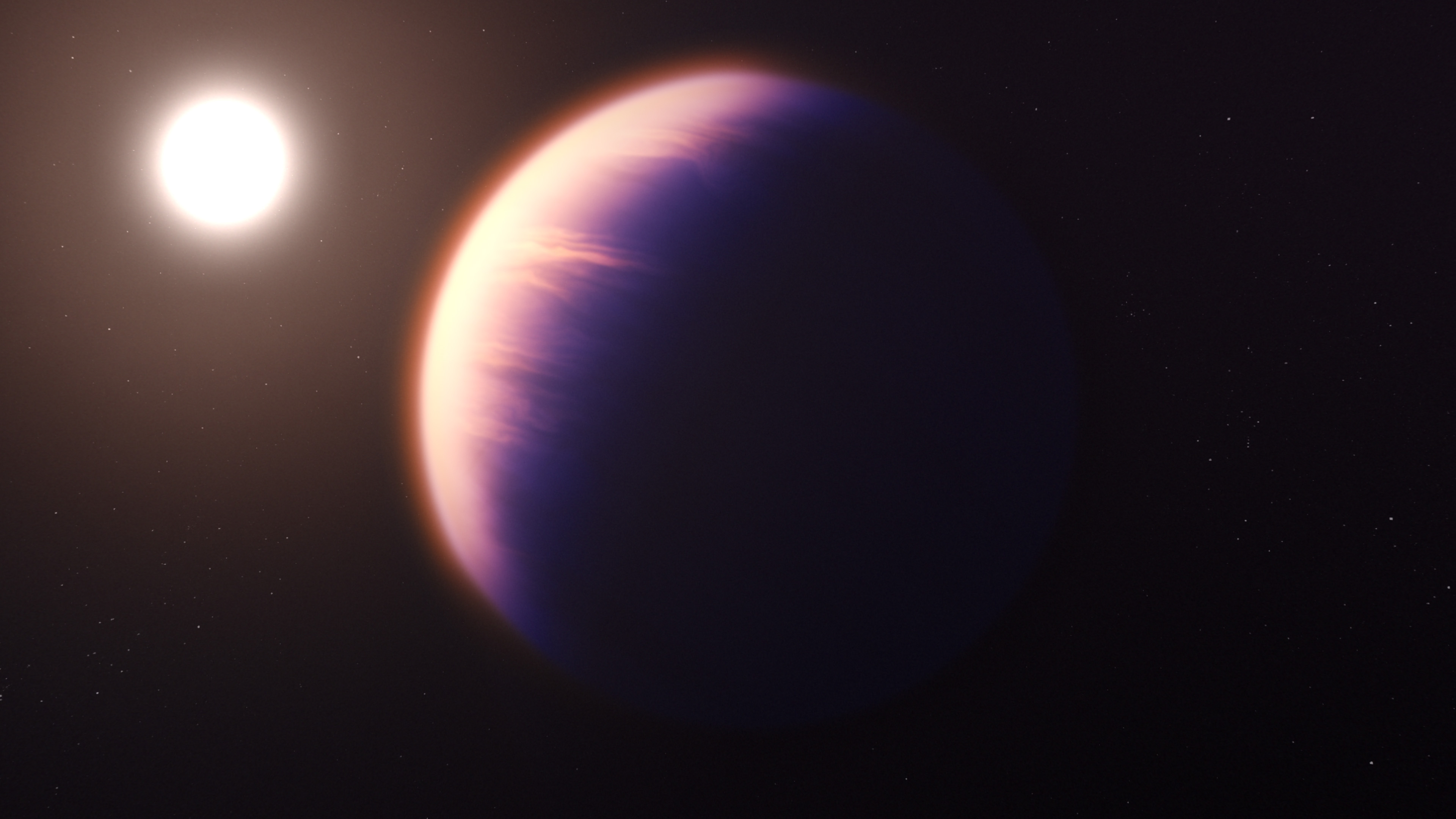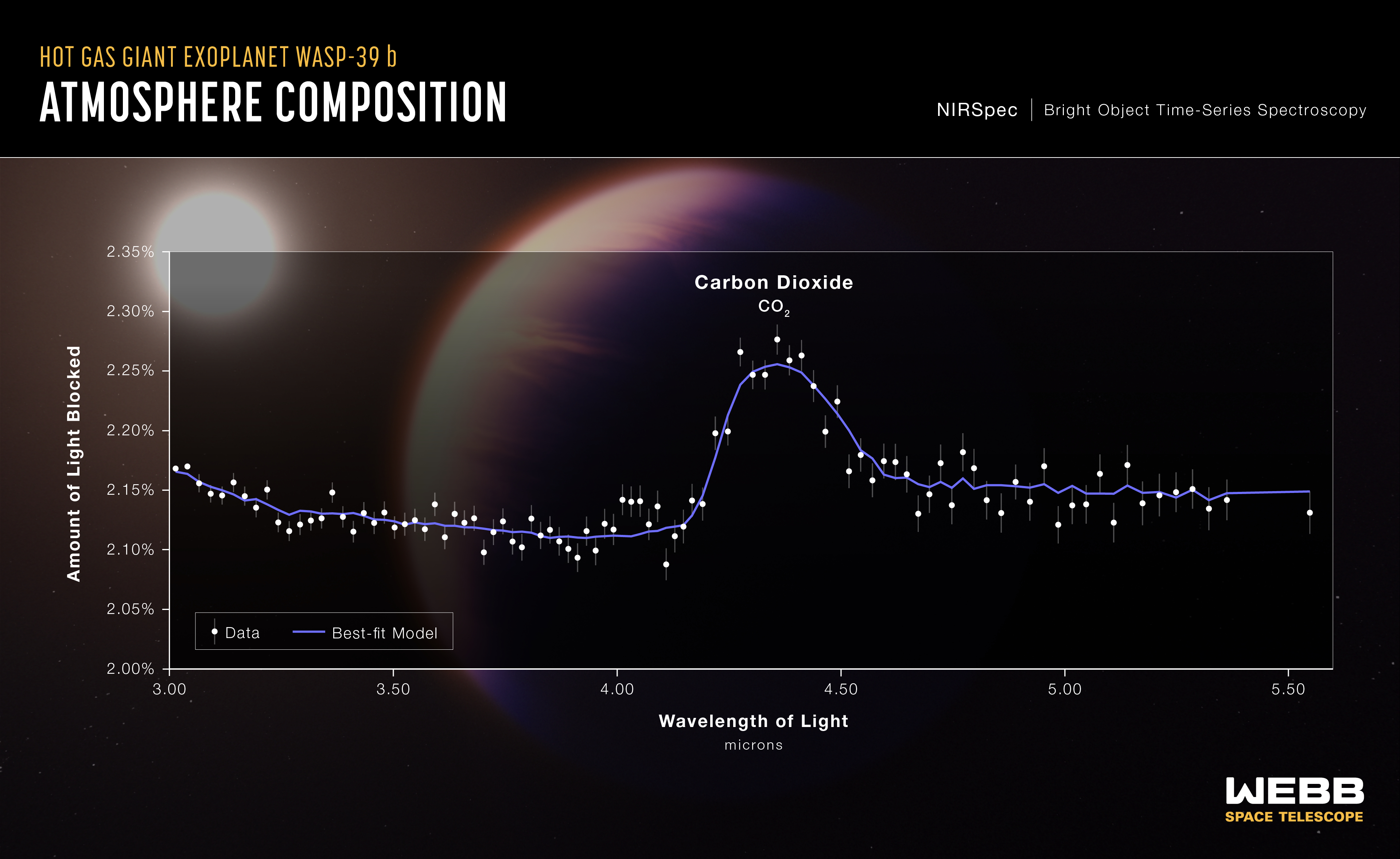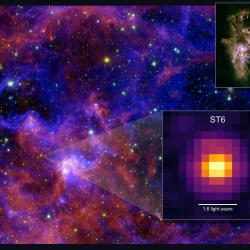NASA’s Webb Telescope Detects First Evidence of Carbon Dioxide in Exoplanet Atmosphere
UMD astronomers Eliza Kempton and Thaddeus Komacek were part of the research team that analyzed the spectrum of WASP-39 b
NASA’s James Webb Space Telescope has captured the first clear evidence for carbon dioxide in the atmosphere of a planet outside the solar system. This observation of WASP-39 b, a gas giant planet orbiting a sun-like star 700 light-years away, provides important insights into the composition and formation of the planet. The finding, which is accepted for publication in the journal Nature, is also indicative of Webb’s unique ability to detect and measure carbon dioxide in the thinner atmospheres of smaller rocky planets.

WASP-39 b has a mass roughly one-quarter that of Jupiter (about the same as Saturn) and a diameter 1.3 times greater than Jupiter. Its extreme puffiness is related in part to its high temperature (about 1,600 degrees Fahrenheit or 900 degrees Celsius). Unlike the cooler, more compact gas giants in our solar system, WASP-39 b orbits very close to its star—only about one-eighth the distance between the sun and Mercury—completing one circuit in just over four Earth-days. The planet’s discovery, reported in 2011, was made based on ground-based detections of the subtle, periodic dimming of light from its host star as the planet transits, or passes, in front of the star.
Previous observations from other telescopes, including NASA’s Hubble and Spitzer space telescopes, revealed the presence of water vapor, sodium and potassium in the planet’s atmosphere. Webb’s unmatched infrared sensitivity has now confirmed the presence of carbon dioxide on this planet as well.
“The reason we hadn't been able to definitively identify CO2 in the atmosphere of WASP-39 b previously was that we never had a telescope that could produce spectra across the right wavelength range,” said Eliza Kempton, an associate professor of astronomy at the University of Maryland. “This discovery shows us that Webb is delivering on its promise of being a transformational facility for astronomical observations.”
Kempton and UMD Assistant Professor of astronomy Thaddeus Komacek are members of the research team that made this discovery.
Filtered Starlight
Transiting planets like WASP-39 b, whose orbits we observe edge-on (or from the side) rather than from above, can provide researchers with ideal opportunities to probe planetary atmospheres.
During a transit, some of the starlight is eclipsed by the planet completely (causing the overall dimming) and some is transmitted through the planet’s atmosphere.
Because different gases absorb different combinations of colors, researchers can analyze small differences in brightness of the transmitted light across a spectrum of wavelengths to determine exactly what an atmosphere is made of. With its combination of inflated atmosphere and frequent transits, WASP-39 b is an ideal target for transmission spectroscopy.
First Clear Detection of Carbon Dioxide
The research team used Webb’s Near-Infrared Spectrograph (NIRSpec) for its observations of WASP-39 b. In the resulting spectrum of the exoplanet’s atmosphere, a small hill between 4.1 and 4.6 microns presents the first clear, detailed evidence for carbon dioxide ever detected in a planet outside the solar system.
Kempton received an early version of the spectrum—before anyone had labeled its features—and said the presence of carbon dioxide was immediately apparent.

“The shape of the spectrum is unmistakable to someone like me who models exoplanet atmospheres for a living,” she said. “This is very different from all previous exoplanet atmosphere observations where we would typically go through a much more involved process of comparing many different possible atmosphere models to the data to convince ourselves that we've detected a specific atom or molecule. For the Webb observation of WASP-39 b, the CO2 is just sitting there in plain sight, waving, ‘Hello! I'm here!’"
No observatory has ever measured such subtle differences in brightness of so many individual colors across the 3 to 5.5-micron range in an exoplanet transmission spectrum before. Access to this part of the spectrum is crucial for measuring abundances of gases like water and methane, as well as carbon dioxide, which are thought to exist in many different types of exoplanets.
“Detecting such a clear signal of carbon dioxide on WASP-39 b bodes well for the detection of atmospheres on smaller, terrestrial-sized planets,” said Natalie Batalha of the University of California at Santa Cruz, who leads the team.
Understanding the composition of a planet’s atmosphere is important because it tells us something about the origin of the planet and how it evolved.
“Carbon dioxide molecules are sensitive tracers of the story of planet formation,” said Mike Line of Arizona State University, another member of the research team. “By measuring this carbon dioxide feature, we can determine how much solid versus how much gaseous material was used to form this gas giant planet. In the coming decade, JWST [Webb] will make this measurement for a variety of planets, providing insight into the details of how planets form and the uniqueness of our own solar system.”
Early Release Science
This NIRSpec prism observation of WASP-39 b is just one part of a larger investigation that includes observations of the planet using multiple Webb instruments, as well as observations of two other transiting planets. The investigation, which is part of the Early Release Science program, was designed to provide the exoplanet research community with robust Webb data as soon as possible.
“The goal is to analyze the Early Release Science observations quickly and develop open-source tools for the science community to use,” explained Vivien Parmentier, a co-investigator from Oxford University. “This enables contributions from all over the world and ensures that the best possible science will come out of the coming decades of observations.”
Thanks to the advanced capabilities of Webb, Kempton said the discovery of carbon dioxide in WASP-39 b’s atmosphere is the beginning of a long and fruitful exploration of exoplanets.
“It is just the tip of a huge iceberg,” Kempton said. “We expect that hundreds of exoplanets will be observed by Webb over the telescope's lifetime.”
###
This article is adapted from text provided by the Space Telescope Science Institute.







